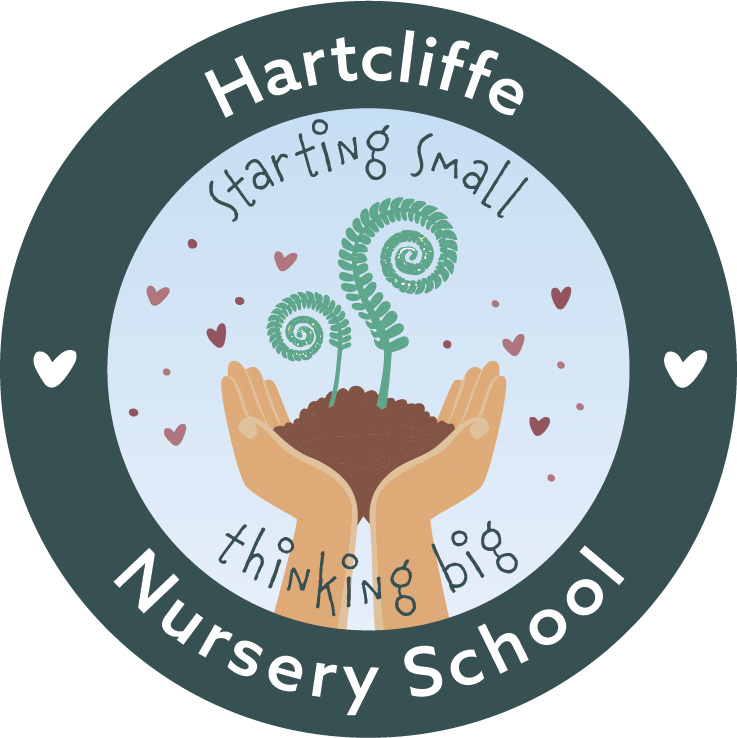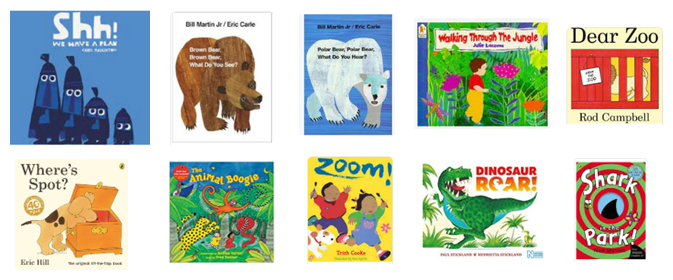Storytelling Policy and Approach
At Hartcliffe Nursery School, Communication and Language is our priority and key to enabling every child to be able to express themselves through language and build their vocabulary. One effective way to develop children’s language is through storytelling and sharing books, so we have been developing our telling of stories and core book approach.
The books were chosen by staff as high-quality books and stories that support children’s communication, language and literacy development. We recognise the importance of the books we read reflect our diverse community and the emotional development needs of our children.
Click here to view the Core Books.
Download as a PDF
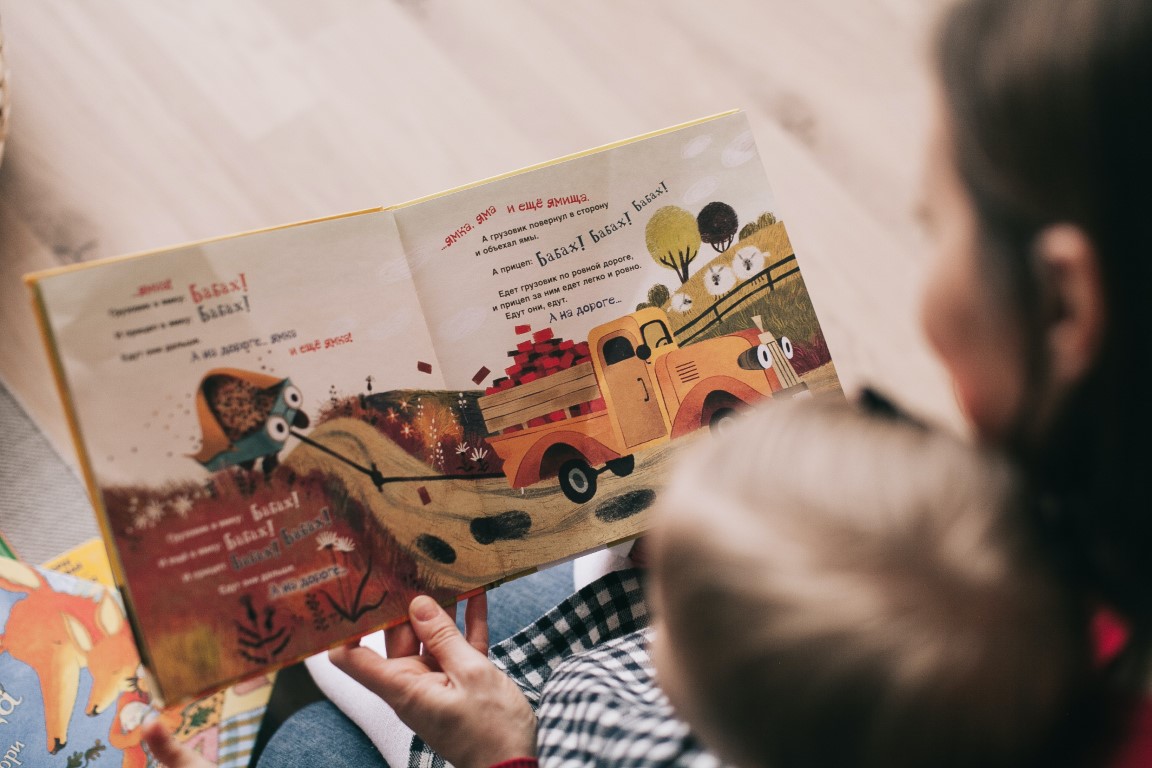
Photo by Lina Kivaka
Through storytelling and dramatic play, children, with the help of observant teachers, develop a classroom environment- their society based on rules of what I call the three f’s: Fairness, Fantasy and Friendship.
Rationale – Why do we believe storytelling is so important?
- A shared experience, fostering group togetherness, a sense of belonging. Giving personal attention – being told a story by someone important to you; building relationships with the group and each other.
- Ignites children’s imaginations, encouraging creativity and critical thinking.
- Develops and extends children’s communication and language.
- Develops children’s listening and attention skills.
- Learning new vocabulary in a meaningful way.
- Builds and supports emotional development and emotional literacy. There are opportunities to experience feelings/ emotions in a safe way, being scared for example.
- Develops empathy and appreciate others’ points of view.
- Broadens horizons; supports experiencing new things, cultures and concepts.
- Focuses children, creates a sense of calm.

 What does the DfE EYFS Statutory Framework say?
What does the DfE EYFS Statutory Framework say?
Educational Programme – Communication and Language
The development of children’s spoken language underpins all seven areas of learning and development. Children’s back-and-forth interactions from an early age form the foundations for language and cognitive development.
The number and quality of the conversations they have with adults and peers throughout the day in a language-rich environment is crucial.
By commenting on what children are interested in or doing, and echoing back what they say with new vocabulary added, practitioners will build children’s language effectively.
Reading frequently to children, and engaging them actively in stories, non-fiction, rhymes and poems, and then providing them with extensive opportunities to use and embed new words in a range of contexts, will give children the opportunity to thrive.
Through conversation, story-telling and role play, where children share their ideas with support and modelling from their teacher, and sensitive questioning that invites them to elaborate, children become comfortable using a rich range of vocabulary and language structures.
Educational Programme – Literacy
It is crucial for children to develop a life-long love of reading. Reading consists of two dimensions: language comprehension and word reading. Language comprehension (necessary for both reading and writing) starts from birth. It only develops when adults talk with children about the world around them and the books (stories and non-fiction) they read with them, and enjoy rhymes, poems and songs together…
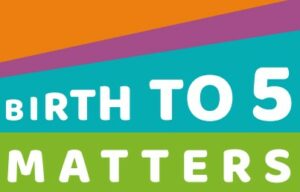 Literacy – Birth to 5 Matters 2021 Page 48
Literacy – Birth to 5 Matters 2021 Page 48
Developing literacy competence and skills is a complex, challenging yet rewarding journey that requires high-quality pedagogical activities to enhance learning. Young children need to be listened to by attentive adults who recognise and value children’s choices.
They need enjoyable, playful opportunities of being included and involved in the literacy practices of their home, early years setting, and community environments. They need experiences of creating and sharing a range of texts in a variety of ways, with different media and materials, with adults and peers, both indoors and outdoors, as well as learning about using different signs and symbols, exploring sound and developing alphabetic and phonetic skills.
Literacy is about understanding and being understood.
Early literacy skills are rooted in children’s enjoyable experiences from birth of gesturing, talking, singing, playing, reading and writing. Learning about literacy means developing the ability to interpret, create and communicate meaning through writing and reading in different media, such as picture books, logos, environmental print and digital technologies.
It involves observing and joining in the diverse ways that different people and communities use literacy for different purposes. Most importantly, literacy is engaging, purposeful and creative.
Curriculum Goal – I Can Re-tell a Familiar Story
When planning for storytelling, we have considered what the developmental stages and small steps might be for a child. We have thought about:
- What is it that we would like the children to learn and develop?
- How might we model, scaffold, use language that will develop this skill/ knowledge?
We have used the DfE Development Matters Guidance, Birth to 5 Matters Guidance and Bristol Differentiated Early Years Outcomes (DEYO) (written in bold italics) to guide us. They inform our planning and observations.
Intention – what we want the children to learn
Default
Hidden
First Milestone Babies, toddlers – Birth to 3
- Focuses attention on visual stimuli such as objects of reference.
- Shows interest in looking and reaching towards visual stimuli e.g. tactile books.
- Listens to, enjoys rhythmic patterns in rhymes and stories responds, smiling, making eye contact.
- Joins in with sounds, actions and noises adult makes.
- Shows interest in play with sounds, songs and rhymes.
- Interested in and explores the sounds made by banging and tapping simple instruments.
- Waves, taps, claps, stamps etc to simple rhythms in stories, songs and rhymes.
- Chooses to engage with small world/role play.
Second Milestone
- Tracks a visual stimulus. (2)
- Shows a response to rhythmic activities e.g. resonance board, in storytelling. (2)
- Listens to familiar stories with increasing attention and recall.
- Has favourite stories and enjoys sharing a book with an adult.
- Pays attention and responds to the pictures or the words.
- Repeats and uses actions, words/ phrases from familiar stories.
- Fills in the missing word or phrase in a known story or rhyme. …’using a preferred mode of communication e.g Big Mac switch, symbols, signing’.
- Shows anticipation of repeated refrain or key moment in a familiar story or rhyme.
- Notices pictures and symbols in books. Decodes a single symbol.
- Uses imagination when playing with resources, for example, ‘roaring tiger’.
Third Milestone
- Joins in with repeated refrains, ‘Trip, trap’ and anticipates key events and phrases in rhymes and stories using a preferred mode of communication e.g. Big Mac, symbols or signing.
- Develops play around favourite stories acting out using props. Remembers some key parts
- Aware of the way stories are structured.
- Talks about events and characters in stories using words, photographs or picture symbols.
- Suggests how the story might end.
- Asks questions and make comments about the book/ story.
- Beginning to re-tell simple stories with beginning, middle and end.
- Is beginning to retell stories using the props provided.
Final Milestone
- Knows that print carries meaning, and has different purposes, and, in English, is read from left to right and top to bottom.
- Knows information can be relayed through signs and symbols in various forms.
- Handles books carefully, turning pages and reading story to themselves or another.
Shows awareness of:
- rhyme and alliteration, hear words starting with the same sound
- recognises rhythm in spoken words, songs, poems and rhymes
- claps or taps the syllables in words during sound play
- hears and says the initial sounds in words
- Uses vocabulary and forms of speech using their preferred mode of communication, that are increasingly influenced by their experiences of reading.
- Describes main story settings, events and principle characters in increasing detail using their preferred mode of communication.
- Re-enacts and reinvents stories they have heard in their play.
- Knows that information can be retrieved from books, computers and mobile devices.
Engages in extended conversations about stories, learning new vocabulary
To support you to develop your language and love of story, we will..
POSITIVE RELATIONSHIPS
- Be expressive; and use facial expressions to make the story more interesting.
- Make links with stories during play, acting out parts of the story, ‘Roaring like a lion, rrr!’
- Model actions and voices for you to join in with.
- Use Makaton signs, visuals and speech to convey meaning and help you understand the story.
- Find out what stories you like at home.
- Draw your attention to the pictures and hold authentic conversations about what you notice.
- Give you time to think, notice, wonder and not interrupt you. To follow your interest in the story or pictures. Respond to your ideas and follow your lead.
ENABLING ENVIRONMENTS
- Create comfy spaces inside and outside including dens, circles and in the forest.
- Provide you with a range of high-quality books that interest you and follow your fascinations.
- Make sure all books reflect reality, your experiences and the culturally diverse world that we live in. You will be able to see yourself in the story.
- Provide small world resources to enable and inspire you to tell your own stories.
- Use props and visuals to bring the story alive and help you understand it.
- Use books with beautiful, interesting illustrations to engage you.
- Provide non-fiction books so that you can learn about the world around you.


Core Books
Core books have been selected to encourage children to engage actively with the story. This includes books with ‘lift the flaps’, joining in with sounds and actions, anticipation, repetition and those with ‘active’ rhythms.
They will also have experienced action songs and nursery rhymes regularly as well as ‘Chatter Box’. This will provide children with a rich experience of language, vocabulary, rhythm and rhyme.
Core Story Stages
We have put the books into six stages that will support the development of children’s communication, language and literacy skills and knowledge.
(Adapted from Ilminster Avenue Nursery School stages)
Stage 1 Books
Books that promote participation and enjoyment. Stories that encourage joining in with sounds and actions. Stories that have simple text that uses rhythm. Stories that clearly focus on the use of simple verbs e.g. walking. Stories with a strong story structure.
Stage 2 Books
Stories with a simple but clear story structure, repeated refrains or structured phrases that repeat throughout. This will help to build memory of text and recall. There will be an emphasis on vocabulary, looking closely at new and unfamiliar words.
Stage 3 Books
Traditional tales with focus on story structure and retelling of stories. Enabling children to play at retelling stories. Stories with repeated refrains to support recall and building memory of story language and story vocabulary. Story of 3 Pie Corbett ‘Talk for Writing’. Building on and developing story language vocabulary e.g. ‘Once Upon a time..’
Stage 4 Books
Stories that introduce problem-solving ideas. Stories that encourage children to make predictions and anticipate what might come next. Stories that encourage children to sequence events and recall this sequence. Building on and developing story language vocabulary e.g. Once Upon a time.
Stage 5 Books
Stories that focus on phonics and rhyming, encouraging children to see the rhyme to guess the final word or to begin to play with creating their own rhymes. Encouraging children to summarise stories, showing they can recall events. Building on making predictions about the end of the story.
Stage 6 Books
Also introducing stories that extend the narrative and continue to introduce new vocabulary. Encouraging children to listen to and enjoy longer stories. Encourages critical thinking and problem-solving.
Guidance for Using Books to Tell Stories
The guidance below details each particular book, gives suggestions on how to engage children when reading the story, suggested activities that link to the book, and suggestions for other books that relate thematically and/or linguistically.
Note: Check back, as we’re in the process of adding more books!
Default
Hidden
Red, Red, Red by Polly Dunbar
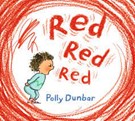 This book supports children’s C&L and PSED development. Through rhyming text and a simple narrative, the story introduces the idea of how to calm down after feeling angry. This supports children to notice how the character is feeling and relate this to their own experiences. It models a positive relationship between the child and their Mum, who supports them to remember how to calm down. This book opens up discussion about feeling angry, what can make someone angry and what can be done about it.
This book supports children’s C&L and PSED development. Through rhyming text and a simple narrative, the story introduces the idea of how to calm down after feeling angry. This supports children to notice how the character is feeling and relate this to their own experiences. It models a positive relationship between the child and their Mum, who supports them to remember how to calm down. This book opens up discussion about feeling angry, what can make someone angry and what can be done about it.
Suggestions for engaging children in the book:
- Support children to name the emotions and relate this to our other core book, The Colour Monster.
- Model acting out being ‘angry’ in appropriate ways.
- Practice counting to 10 together and remind children about breathing in and out slowly to feel calm.
- Discuss and record what makes them feel angry.
- Discuss what they do when they’re feeling angry to feel better. You could introduce other strategies e.g. squeezing a ball, hugging a soft toy.
- Talk about who can help them when they feel angry.
- Act out the story with people and pretend cookies.
Suggested linked activities:
- For the counting strategy to work, children need to feel confident with rote counting to 5 and then to 10. Practice this in different ways e.g. through songs, rhymes, counting during play etc.
- Meditation time. Introduce children to this by playing calming music, lying or sitting on the floor, breathing slowly with eyes closed.
- Introduce children to yoga to support them to breath and move slowly and calmly. There are lots of videos on YouTube of children’s yoga e.g. Cosmic Kids.
- Have a sensory box available in the classroom for children with calming resources e.g. squeezing balls, pipits, liquid motion timers, sensory bottles etc.
- Create a calming den in the classroom as a quiet, dark space for children to experience.
Suggested linked books:
- Angry Arthur by Hiawyn Oram
- The Rabbit Listened by Cori Doerrfeld
- Grumpy Monkey by Suzanne Lang
Pete the Cat (I love my white shoes) by Eric Litwin
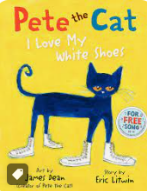 This book has simple repetitive phrases for children to join in with which can be sung to support children’s engagement. As Pete walks along children are prompted to predict what colour his shoes will turn, and at the end, to recall what colour they were at the beginning. This story also promotes resilience in the face of things going a bit wrong.
This book has simple repetitive phrases for children to join in with which can be sung to support children’s engagement. As Pete walks along children are prompted to predict what colour his shoes will turn, and at the end, to recall what colour they were at the beginning. This story also promotes resilience in the face of things going a bit wrong.
Suggestions for engaging children in the book:
- Sing the ‘song’ using a consistent tune for the children to learn and repeat.
- Move and dance to the song as you read the story.
- Leave gaps when telling the story for children to fill e.g. “Pete stepped in a large pile of….”
- Create a story sack with puppets, story stones/spoons etc.
- Act out the story using real shoes and fruit.
Suggested linked activities:
- Use the fruit from the story in trays with mashers for children to squash. Use the juice to make marks.
- Use mud and water to make marks.
- Use instruments when singing the song with children.
- Extend the story by getting the children to change what Pete steps in – what will it do to his shoes?
Suggested linked books:
- Pete the Cat and his Four Groovy Buttons by Eric Litwin
- Pete the Cat (Rocking in my school shoes) by Eric Litwin
- Wow said the Owl by Tim Hopgood
- Little Rabbit Foo Foo by Michael Rosen
- Chicka, Chicka, Boom, Boom, by Bill Martin Jr.
Wake Up Do, Lydia Lou! By Julia Donaldson
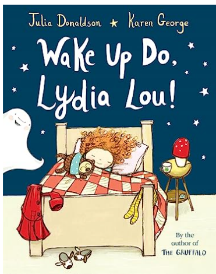 This book contains a repeated rhyming refrain, and variations and repetitions of rhyming ‘oo’ words. This provides opportunities for children to join in with the familiar aspects of the story, become familiar with rhyme and practice vocalising a specific sound. This supports different aspects of children’s early phonics and literacy skills. This book also prompts children to predict and recall the different animals the ghost brings in to help him. The text itself uses different font and sizes to emphasise ‘oo’ words which can be used to support children’s early print awareness. High quality illustrations also ensure children are interested in looking at the book with an adult and independently.
This book contains a repeated rhyming refrain, and variations and repetitions of rhyming ‘oo’ words. This provides opportunities for children to join in with the familiar aspects of the story, become familiar with rhyme and practice vocalising a specific sound. This supports different aspects of children’s early phonics and literacy skills. This book also prompts children to predict and recall the different animals the ghost brings in to help him. The text itself uses different font and sizes to emphasise ‘oo’ words which can be used to support children’s early print awareness. High quality illustrations also ensure children are interested in looking at the book with an adult and independently.
Suggestions for engaging children in the book:
- Create a story sack containing the ghost, animals and Lydia Lou. Use this to tell the story and support children to take on roles within the text.
- Use costumes (animal head bands, hats, fabric etc.) as another way for children to take on roles, retell the narrative and use language from the story.
- When reading the book, emphasise the ‘oo’ words using different tones and volumes.
- Before reading the story, support children to spot what animals they can see on the front cover. They can then use this knowledge to predict what animals the ghost will fetch for help.
- Encourage children to join in with the ghost’s words- they could shout the words!
- Encourage children to recall and use the words used by the animals by leaving pauses in your story e.g. “And the cow said…”
- Ensure you are using your voice effectively (alter your volume, tone, expression, pauses etc.)
- Use Makaton signs for the ghost, animals and Lydia Lou to support all children to be able to join in and to support recall of the story.
- Draw attention to the small changes in Lydia Lou throughout the story; what might they mean?
- When children are familiar with the story encourage them to think about questions to extend the story e.g. why does the ghost want to scare Lydia Lou? What could the ghost have done differently to really wake her up? How would they wake her up if they were the ghost?
- Create a story map for the book to support children to recall the order and sounds.
Suggested linked activities:
- Leave story sack/stones/spoons or stick puppets in the small world area for children to use within their own play.
- Introduce around Halloween when lots of children may become interested in ghosts.
- Extend the story by encouraging children to change the characters involved – they can think about what animals/objects might be better at waking someone up.
- Change the story by using other animals that make rhyming noises e.g. Lion (Raar), Sheep (Baa), Goat (Maa), Crow (Caar).
- Continue children’s introduction to rhyme through games and resources e.g. silly soup (see Letters & Sounds phase 1), a rhyming basket with a selection of objects that rhyme, rhyming pairs using objects and pictures, memory games using rhyming objects, using silly rhymes for children’s names and during transitions etc. You can also ensure you have objects that rhyme in with your usual classroom resources e.g. in the water tray which you can draw children’s attention to.
- Notice and draw attention to rhyme in other books and songs.
Suggested linked books:
- A Squash and a Squeeze by Julia Donaldson
- Chocolate Mouse for Greedy Goose by Julia Donaldson
- Duck in the Truck by Jez Alborough
- Sheep in a Jeep by Nancy E. Shaw
- Where’s my Teddy by Jez Alborough
Julian is a Mermaid by Jessica Love
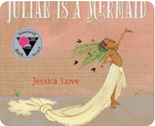 This book is a positive representation of black characters who also challenge gender stereotypes. Julian wants to dress up, wear make-up and be a mermaid which his Nana is supportive of. This book has few words, with the focus on the captivating illustrations. The illustrations invite children to interpret what is happening; providing lots of language development opportunities. This also makes the book accessible to all children. The beautiful illustrations also model an imaginative use of resources for dressing up and has positive representations of different body shapes and sizes. More widely, the book opens up discussions about children’s dreams and ideas of what they want to be.
This book is a positive representation of black characters who also challenge gender stereotypes. Julian wants to dress up, wear make-up and be a mermaid which his Nana is supportive of. This book has few words, with the focus on the captivating illustrations. The illustrations invite children to interpret what is happening; providing lots of language development opportunities. This also makes the book accessible to all children. The beautiful illustrations also model an imaginative use of resources for dressing up and has positive representations of different body shapes and sizes. More widely, the book opens up discussions about children’s dreams and ideas of what they want to be.
Suggestions for engaging children in the book:
- With so few words, encourage the children to tell you what is happening in the story. You can also model this to children with low levels of language development.
- Encourage children to spend time looking in detail at the pictures and really thinking about what is happening.
- Use different fabrics and beads for children to feel and look at in relation to the story. What would they use to be a mermaid?
- Discuss why people might be dressing up and where they could be going.
Suggested linked activities:
- For staff teams: Challenge gender stereotypes in the classroom and be reflective of your resources e.g. are the baby clothes all pink? As a staff team you can play the “If it had a gender, what gender would it be?” by focusing on different areas of the room and identifying if it looks stereotypically gendered or is neutral. As a team you can reflect on how to adapt the environment.
- Provide a range of resources for children to use to dress up in creative and open-ended ways e.g. ribbons, tissue paper streamers, necklaces (making their own with pasta etc), real herbs, sticks and leaves, headbands etc.
- Create costumes and go on your own parade with instruments.
- Julian wants to be a mermaid. Discuss, draw and scribe what children dream they could be.
- Look at images of people challenging gender stereotypes e.g. merman, female knight, and having these images displayed in the classroom for children to see.
- Play small group activities which challenge gender stereotypes e.g. colour sorting in girl and boy colours (this is good to do if you know you have a girl who likes a stereotypical boy colour etc. or an adult can fill that role). Challenge the sorting of the colours e.g. I’m a girl and I like red or I’m a girl and I don’t like pink. Do the children come to any ideas of how to solve this? Can the colours be for everyone?
- Julian’s Nana supports him to be truly himself, and be proud of his costume. What are the children proud of? What makes them special? Celebrate what children and carers tell you.
Suggested linked books:
- Clive and his Babies (series) by Jessica Spanyol
- Rosa Loves Dinosaurs (series) by Jessica Spanyol
- Baking with Dad by Aurora Cacciapuoti
- The Worst Princess by Anna Kemp
- Dog’s Don’t Do Ballet by Anna Kemp
- Nen and the Lonely Fisherman by Ian Eagleton and James Mayhew
- Julian at the Wedding by Jessica Love
- The Odd Egg by Emily Gravett
Shark in the Park by Nick Sharratt
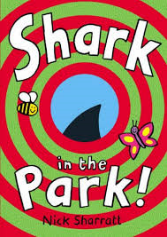 This book has a repeating rhyming refrain which children can join in with. The ‘peep holes’ throughout the book encourage children to predict what they think will happen on the next page. The park offers a familiar setting for most children with bright images for children to spot other things in the park. The final page sets up a visual joke for the children.
This book has a repeating rhyming refrain which children can join in with. The ‘peep holes’ throughout the book encourage children to predict what they think will happen on the next page. The park offers a familiar setting for most children with bright images for children to spot other things in the park. The final page sets up a visual joke for the children.
Suggestions for engaging children in the book:
- Encourage children to join in with the repeated refrains. They can shout the main phrase of “There’s a shark in the park!”
- Introduce key vocabulary of ‘telescope’. support children to pronounce this word by breaking it down in to syllables and clapping these as you say the word e.g. tel/es/scope.
- Use tubes for children to look through and copy the actions of Timothy Pope.
- Read the story in the forest area and encourage children to see what they can see through their own ‘telescopes’.
- Encourage children to predict what Timothy is seeing.
- Support children to recall all the things Timothy spotted in the park.
- Discuss why Timothy makes mistakes when he spots things through his telescope.
Suggested linked activities:
- Use tubes to create and decorate telescopes.
- Introduce children to real telescopes and binoculars, supporting children to notice how they make objects appear nearer.
- In the classroom and outside, play ‘I spy’ or ‘I can see’ games. Use these games to support children to look closely at details in their environment and to introduce new vocabulary.
- Play rhyming games e.g. rhyming pairs using rhyming objects, rhyming soup using a collection of rhyming objects, making up nonsense rhymes with children’s names etc.
- Introduce concept of who else uses telescopes and why. Support children to understand more about these roles through books, google and role play e.g. sailors, pirates, astronomers, astronauts etc.
Suggested linked books:
- Shark in the Park on a Windy Day/ In the Dark/ In the Snow by Nick Sharratt
- Oi Frog (series) by Kes Gray & Jim Field
- There’s a Bear on My Chair by Ross Collins
- One Mole Digging a Hole by Julia Donaldson
- Each Peach Pear Plum by Allan Ahlberg and Janet Ahlberg
Owl Babies by Martin Waddell
 With engaging illustrations, this story supports children to explore emotions related to an adult being absent. It has repeated refrains which children can join in with to support them to engage and relate to the story. This book is great at encouraging children to talk about their worries and concerns about separation from their families, especially when they are new to nursery.
With engaging illustrations, this story supports children to explore emotions related to an adult being absent. It has repeated refrains which children can join in with to support them to engage and relate to the story. This book is great at encouraging children to talk about their worries and concerns about separation from their families, especially when they are new to nursery.
Suggestions for engaging children in the book:
- Use a story sack to tell the story and to give children physical props to hold.
- Encourage children to talk about how the owls are feeling throughout.
- Use different voices for the three different owls, highlighting the different sizes and ages of the owls.
- Adjust your tone to reflect the emotions throughout the story.
- Create a sensory experience by making a dark den to read the story in, with branches, sticks and leaves for the children to feel.
Suggested linked activities:
- Create a sensory tray with sticks, leaves, stones and story props for children to explore.
- Create a dark den and play night forest noises for children to listen to.
- Visit the forest area and discuss where the owls might live.
- Discuss what children can do if they feel worried e.g. have a hug, play with their favourite toy etc.
- Discuss and record how children feel if their grown up has gone and how they feel when they come back.
- Discuss who is in children’s families/who is important to them and how they know they are loved.
Suggested linked books:
- Can’t You Sleep Little Bear by Martin Waddell
- Guess How Much I Love You by Sam McBratney
- Harris Finds His Feet by Catherine Rayner
- A Bit Lost by Chris Haughton
- Don’t Worry, Little Crab by Chris Haughton
Peace at Last by Jill Murphy
 This classic story is full of repeated refrains and environmental sounds. By focusing on a familiar routine of a family going to bed, children can relate to this and connect the story to their own experiences; maybe their Mummy snores too! The narrative is simple and repetitive, meaning children can practice their prediction and recall skills. It also has beautiful coloured illustrations that reflect the text, next to black and white pictures that add additional points to the story (did you spot that Mr Bear has a midnight sandwich before trying to sleep in the kitchen?).
This classic story is full of repeated refrains and environmental sounds. By focusing on a familiar routine of a family going to bed, children can relate to this and connect the story to their own experiences; maybe their Mummy snores too! The narrative is simple and repetitive, meaning children can practice their prediction and recall skills. It also has beautiful coloured illustrations that reflect the text, next to black and white pictures that add additional points to the story (did you spot that Mr Bear has a midnight sandwich before trying to sleep in the kitchen?).
Suggestions for engaging children in the book:
- Use lots of expression and gestures alongside the environmental sounds and repeated refrains to support children to remember them and join in.
- Create a story sack with props for children to use to make the sounds and to recall the order of the story.
- Encourage children to join in with the sounds and repeated refrains by leaving gaps for them to fill e.g. “Oh no!” said Mr Bear, “I…”
- Use sound buttons or other sound recordings of the environmental sounds for children to play, listen and identify.
- Use simple sequence pictures for children to order and retell the story.
- Create a story map of the story to support children to recall the sequence and key vocabulary.
Suggested linked activities:
- Play environmental sound Bingo with CDs or sound recordings on YouTube.
- Play listening games during small group time to practice children’s listening and attention skills e.g. Noisy Neighbours. See Letters & Sounds Phase 1 for other environmental sound games.
- Leave story props in the classroom for children to use independently.
- Retell the story in the home corner with children taking on different roles.
- Change and adapt the story e.g. different family, different sounds keeping one character awake, different locations etc.
Suggested linked books:
- The Gingerbread Man
- Room on the Broom by Julia Donaldson
- We’re Going on a Bear Hunt by Michael Rosen
- Down by the Cool of the Pool by Tony Mitton
- The Ding-Dong Bag by Polly Peters
- This is the Bear (series) by Sarah Hayes
You Choose by Nick Sharratt and Pippa Goodhart
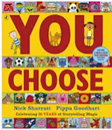 This book is a little different as it’s not a story and has few written words. Instead it has hundreds of pictures in different categories e.g. homes, clothes, food, animals etc. This opens the book up to being used in a wide variety of ways depending on the children and time of place. The images prompt children to recall their current noun vocabulary (car) and be introduced to new linked vocabulary (limousine). There is lots of opportunity to expand children’s vocabulary through descriptive words, prepositions, and conversations linked to the children’s choices and interests. The book can also be used to support children to create their own narrative
This book is a little different as it’s not a story and has few written words. Instead it has hundreds of pictures in different categories e.g. homes, clothes, food, animals etc. This opens the book up to being used in a wide variety of ways depending on the children and time of place. The images prompt children to recall their current noun vocabulary (car) and be introduced to new linked vocabulary (limousine). There is lots of opportunity to expand children’s vocabulary through descriptive words, prepositions, and conversations linked to the children’s choices and interests. The book can also be used to support children to create their own narrative
Suggestions for engaging children in the book:
- Encourage children to pick a page to focus on, let them take the lead with what interests them and what they want to talk about.
- Choose a page to focus on as an introduction to then looking at objects of interest. E.g. look at the hats page, discuss the different styles of hats and then try on lots of real hats. Link the learnt vocabulary and introduce descriptions about texture and size.
- Introduce children to linking choices together e.g. what will you wear on your body, your feet and your head. You could draw the children’s choices to create a complete image.
- Play ‘I spy’ using colours, initial sounds, noises, rhymes, amounts, habitats, any category you can think of!
Suggested linked activities:
- When using the book in a group, highlight and discuss the differences and similarities in children’s choices. This supports children to learn that different people have different ideas and life experiences to themselves. You can also model this discussion 1:1 by making different choices to the child.
- Introduce children to creating a narrative. Choose a character, where do they live, where will they go, how will they get there, who will they meet, what will they do etc. This could be done 1:1 or with a small group. Draw and scribe children’s choices as a visual for their story.
Suggested linked books:
- Would You Rather by John Burningham
- Ketchup on Your Cornflakes by Nick Sharratt
- Flip Flap Dogs by Nikki Dyson
- Flip Flap Ocean by Axel Scheffler
- You Choose Fairy Tales by Nick Sharratt
Lima’s Red, Hot Chilli by David Mills
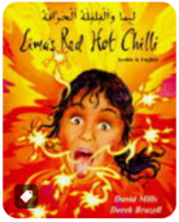 This book features different family members who all come to the aid of Lima when she eats a red-hot chili. The story reflects a common experience of looking for something to eat, but also introduces foods that may be less common for some of our children. Lots of vocabulary is highlighted within the text to describe each food. The repeated refrain of “But her mouth was still too hot!” offers opportunities for children to join in with the story.
This book features different family members who all come to the aid of Lima when she eats a red-hot chili. The story reflects a common experience of looking for something to eat, but also introduces foods that may be less common for some of our children. Lots of vocabulary is highlighted within the text to describe each food. The repeated refrain of “But her mouth was still too hot!” offers opportunities for children to join in with the story.
Suggestions for engaging children in the book:
- While reading the story, use real food items for children to feel and experience the described texture.
- Discuss what the chilli has done to Lima and encourage the children to predict what she might do about it.
- Support children to predict who will help Lima next.
- Encourage children to join in the repeated refrain.
- Create a story sack with toys/objects and people stick puppets to support children to retell the story.
- Add beats/clapping to the story when the family members are offering different solutions.
- Add noises/sounds for what Lima might make when consuming the different food e.g. glug glug, munch munch.
Suggested linked activities:
- Offer opportunities for children to taste the food from the story. Support them to describe the taste, texture and look.
- Visit the supermarket to buy the food from the story.
- Change the food in the story to introduce children to a wide range of food stuff.
- Discuss who is in Lima’s house to help her and how this compares to children’s own home lives. Support them to draw and record who lives in their homes.
- Create a story map to support children to retell the story.
- Discuss and introduce other types of spicy foods.
Suggested linked books:
- Oliver’s Vegetables by Vivian French
- Hot Hot Roti for Dada-ji by
- Bee-Bim Bop by Linda Sue Park
- Pumpkin Soup by Helen Cooper
So Much by Trish Cooke
 This book is a positive representation of a Black family, with lots of different family members. It’s written in an Afro Caribbean dialect, with rhythmic wording and lots of repetition that helps children remember the words.
This book is a positive representation of a Black family, with lots of different family members. It’s written in an Afro Caribbean dialect, with rhythmic wording and lots of repetition that helps children remember the words.
Children can join in with the repeated refrains. It has a simple narrative that children at different development stages can access. This also means children are able to develop their prediction and recall skills.
It has good quality illustrations which children enjoy looking at and discussing. The main character is a baby and is presented in a gender-neutral way, meaning the baby’s pronouns can be change to make it more relatable to a specific child if needed. A child’s home experiences is the most powerful experience they can relate to; by reading about similar and different home lives, children feel empowered to communicate about their own and respect other people’s.
Suggestions for engaging children in the book:
- This book is written in a different dialect, which means it can take a bit of practice to read it confidently. Listen to others and practice reading the story to ensure you can read the story confidently with lots of rhythm and expression. https://www.youtube.com/watch?v=rJipBPh0xw8
- Encourage children to predict who might be at the door next.
- Discuss how people are feeling in the story, especially during the ‘play fighting’. This is a valuable opportunity to talk about play fighting vs fighting.
- Encourage children to relate the people in the story to people in their own lives.
- Support children to join in with repeated refrains and when they are familiar, with the refrains from the different family members.
- Stick puppets or using small world people can bring the story to life.
Suggested linked activities:
- Discuss who is important to your children. This could be family, carers, friends etc. Support them to discuss what they do with those different people. You can draw/scribe what children say, and/or children could draw their family themselves.
- Discuss how you show someone you love and care about them. Use images from book and others to help children share what they do e.g. hugging, kissing, playing, sharing stories, dancing, etc.
- Birthday’s are a special time to share with family and friends. What other special events happen for your children? You could add resources to the home corner to help children re-enact these events.
- Make birthday cards/cards for people the children care about.
- Family boards- making copies of family pictures to be shared in group. Children can share who is in their family and who is special to them. This can help prompt discussion around similarities and differences between children’s family experiences.
Suggested linked books:
- Daddy, Papa and Me by Leslea Newman
- Mommy, Mama and Me by Leslea Newman
- The Family Book by Todd Parr
- Heather has Two Mummies by Leslea Newman
- Two Homes by Claire Masurel
- The Teazles’ Baby Bunny (An adoption story) by Susan Bagnall
- The Blanket Bears (A foster care story) by Samuel Langley-Swain
- Lola Loves Stories (series) by Anna McQuinn
There’s a Monster in your Book by Tom Fletcher
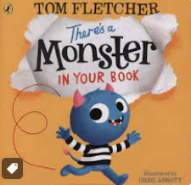 This book encourages children to listen and respond to the narrator to try and get the monster out of the book. It invites children to interact with the book in a physical way e.g. shaking, blowing and spinning. The illustrations are simple and inviting for children to focus on and as the book progresses, they make it appear that the reader is making the monster move. The focus vocabulary within the text is highlighted through different fonts and sizes which supports children to begin to recognise that letters carry meaning.
This book encourages children to listen and respond to the narrator to try and get the monster out of the book. It invites children to interact with the book in a physical way e.g. shaking, blowing and spinning. The illustrations are simple and inviting for children to focus on and as the book progresses, they make it appear that the reader is making the monster move. The focus vocabulary within the text is highlighted through different fonts and sizes which supports children to begin to recognise that letters carry meaning.
Suggestions for engaging children in the book:
- Ensure you read the story with lots of expression, altering your tone, volume and speed.
- Support children to take part in the interactive parts e.g. they all spin the book, they all blow at the book etc.
- Support children to predict what the effect will be on the monster and if he’ll still be in the book.
- Encourage children to see if they can spot the monster in the room when he escapes. Model using lots of prepositions e.g. under, on top, behind, next to etc. Children could say where they think the monster might be.
Suggested linked activities:
- Play ‘where’s the monster’ by hiding a monster toy or image in the room. Encourage children to describe where the monster is using prepositions.
- Support children to listen and follow instructions by playing games e.g. follow the leader, Simon says etc.
- Change the story and make your own e.g. choose a different character to be hiding in the book. How could you get them out?
Suggested linked books:
- Press Here by Herve Tullet
- Let’s Play by Herve Tullet
- From Head to Toe by Eric Carle
- Do Not Open This Book by Andy Lee
- Don’t Push the Button by Bill Cotter
- The Button Book by Sally Nicholls
The Big Book of Feelings Pat-a-Cake
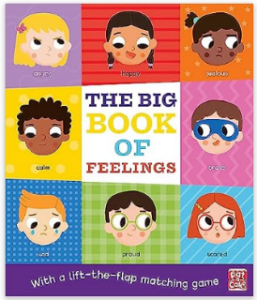 This book supports children’s C&L and PSED skills by exploring different emotions and clearly linking these to a colour. This enables children to learn the labels for different emotions, while also providing examples and a visual for a particular emotion. This supports children to become more aware of their own and other’s emotions. By giving children clear repeated labels for emotions, they are more able to use emotional language and make themselves understood to others.
This book supports children’s C&L and PSED skills by exploring different emotions and clearly linking these to a colour. This enables children to learn the labels for different emotions, while also providing examples and a visual for a particular emotion. This supports children to become more aware of their own and other’s emotions. By giving children clear repeated labels for emotions, they are more able to use emotional language and make themselves understood to others.
Suggestions to engage children in the book:
- Add actions for each emotion e.g. Makaton, actions from the story (crying, stomping).
- Alter your tone and volume for each emotion.
- Create a story sack with puppets, story stones, pictures etc.
- Focus on one emotion at a time – talk about what makes children feel that emotion, what they do when they feel that way etc. Use photos, pictures and mirrors.
Suggested linked activities:
- Emotion display made with the children with images from the story, real people’s facial expressions and children showing different emotions. A mirror could be included to support children to notice their own expressions.
- Make stick puppets, story stones, story spoons etc. of the different emotions to use during group and free play.
- Create colour sensory bottles like the monster’s, discussing the emotion, colour and what makes children feel that emotion. These could be used to support children to talk about how they are feeling at different moments in the classroom, and as a sensory resource to support them to regulate.
- Drawing to music- Listen to a range of music that evokes certain emotions. Support children to make marks linked to how the music makes them feel. Encourage children to think about the colours, patterns and images they want to create.
- Link the colour monster images to the classroom emotion visuals. Check in with children about how they are feeling at Welcome time and throughout the day.
- Create a pictogram for how children are feeling by using images of the coloured jars and children’s photos. Use and model mathematical language to support children to talk about what is represented e.g. Most children feel happy; 3 children feel sad; there is 1 more calm child than scared children.
Suggested linked books:
- Ruby’s Worry by Tom Percival
- Gloomy Baboony by Lizzie Simpson
- The Feelings Book Todd Parr
